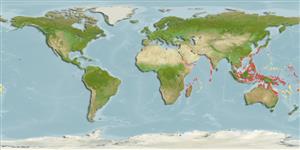>
Gobiiformes (Gobies) >
Gobiidae (Gobies) > Gobionellinae
Etymology: Mugilogobius: Latin, mugil, -ilis = grey mullet + Latin, gobius = gidgeon (Ref. 45335).
Eponymy: Dr Hugo Philip Ralph Merton (1879–1940) was a German zoologist and explorer. [...] (Ref. 128868), visit book page.
More on author: Weber.
Environment: milieu / Klimaatzone / Diepte / distribution range
Ecologie
marien; zoet water; brak water benthopelagisch; amfidroom (Ref. 46888); diepte 0 - 5 m (Ref. 86942). Tropical (Ref. 13275)
Indo Pacific: from South Africa and Seychelles up to Japan, Pakistan, to the Indo-Malaysian archipelago, Papua-New Guinea, New Caledonia, Vanuatu, Australia and Santa Cruz Islands (Ref. 97791).
Grootte / Gewicht / Leeftijd
Maturiteit: Lm ? range ? - ? cm
Max length : 6.0 cm SL mannelijk / geslacht onbekend; (Ref. 57749)
Korte beschrijving
Determinatiesleutels | Morfologie | Morfometrie
Dorsale stekels (totaal) : 7 - 8; Dorsale zachte stralen (totaal) : 6 - 8; Anale stekels: 1; Anale zachte stralen: 6 - 8; Wervels: 25 - 27. Diagnosis: A moderate to large Mugilogobius with second dorsal and anal fin with 1 spine and 6-8 rays; pectoral fin rays 14-17; longitudinal scales 26-37; 12-16 circumpeduncular scales; predorsal scales 9-19, mostly small, central anteriormost scale immediately behind eyes always largest, anteriormost one to four scales larger than those posterior to them; scales on body mostly ctenoid; third spine of first dorsal fin most often longest; body brownish with 7-11 darker narrow diagonal bars, chevrons or X-shaped markings along sides, interspaces between chevrons or bars pale, forming chequered or banded pattern, two to three dark spots or short diagonal bars on caudal base (Ref. 43716).
Body shape (shape guide): fusiform / normal.
Facultative air-breathing in the genus (Ref. 126274); Mainly recorded from mangroves and estuaries, but also found in coastal freshwater streams (Ref. 43716).
Levenscyclus en paargedrag
Maturiteit | Voortplanting | Paaien | Eieren | Fecunditeit | Larven
Larson, H.K. and E.O. Murdy, 2001. Eleotrididae. Sleepers (gudgeons). p. 3574-3577. In K.E. Carpenter and V. Niem (eds.) FAO species identification guide for fishery purposes. The living marine resources of the Western Central Pacific. Vol. 6. Bony fishes part 4 (Labridae to Latimeriidae), estuarine crocodiles. FAO, Rome. (Ref. 42913)
Status op de Rode Lijst van het IUCN (Ref. 130435: Version 2025-1)
Gevaar voor de mens
Harmless
Gebruik door de mens
Tools
Speciale rapporten
Download XML
Internetbronnen
Estimates based on models
Preferred temperature (Ref.
123201): 25 - 29.3, mean 28.5 °C (based on 2341 cells).
Fylogenetische diversiteitsindex (Ref.
82804): PD
50 = 0.5000 [Uniqueness, from 0.5 = low to 2.0 = high].
Bayesian length-weight: a=0.00977 (0.00444 - 0.02153), b=3.04 (2.85 - 3.23), in cm total length, based on LWR estimates for this (Sub)family-body shape (Ref.
93245).
Trofisch niveau (Ref.
69278): 3.5 ±0.4 se; based on size and trophs of closest relatives
Weerstandsvermogen (Ref.
120179): Hoog, minimale populatieverdubbelingstijd minder dan 15 maanden (Preliminary K or Fecundity.).
Fishing Vulnerability (Ref.
59153): Low vulnerability (10 of 100).
🛈
